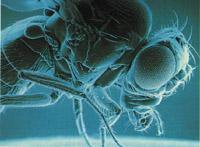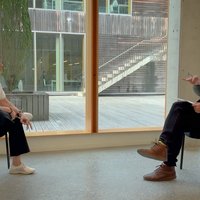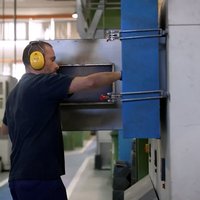Gines Morata Pérez: "Maybe we can replace the organs that age us"

Due to the sequencing of the human genome, in 2000 genetics had a special follow-up in the media. However, much has also been said about the genome of other organisms. The fly drosophila melanogaster is a good example. It is a well-known insect and widely used in laboratories in genetic research. In the March 24 issue of Science magazine it was announced that the entire fly genome was decoded. Although the company Celera Genomics assumed responsibility for the last phases, this work is the result of many projects carried out in numerous laboratories. One of them is directed by biologist Gines Morata Pérez. His laboratory is located at the Autonomous University of Madrid. The CSIC projects are developed here.
In genetics, DNA is considered a basic molecule that stores information. But more and more RNA has spread as the first in evolution. What is then the advantage of DNA?
The advantage of DNA is stability. There are actually beings who use simple RNA, retroviruses. However, the strategy of these beings is to convert RNA into DNA so that contaminated cells maintain it sustainably. Since DNA has a double chain, the interaction between the system is more stable. In addition, RNA also produces a similar interaction to that of its chain in specific locations, but the effect is less strong than that of DNA.
What importance has the experiment of cloned sheep Dolly had in genetics?
Despite its great impact on the press, this experiment has had a relative importance. Cloning is not now. It is a long-developed idea. For example, frogs and other animals have cloned very simply. In the case of Dolly, the innovation lies in the type of animal used, since the sheep is a large mammal. Working with mammalian oocytes is much more difficult than working with frog oocytes. Success is very limited. Only once in every three hundred sessions are good results obtained. From this point of view, Dolly's experiment is a breakthrough, but not because of the conceptual novelty it brings.
Subsequently some characteristics of this experiment have been mentioned. The telomeres of Dolly's cells were shorter than those of another sheep at birth, that is, it was born with the characteristics of an ancient sheep. What is left?
Something has been mentioned about that, but I think nothing clean has come out. Dolly's telomeres were analyzed and were shorter than those of other sheep. However, this has not meant significant biological consequences. No other characteristic of young sheep has been found. Therefore, among most biologists this cloning has remained a mere anecdote.
Can biochemical control of age be achieved?
Maybe in the future. But it is very difficult because in this age control there are many mixed variables. Organisms that are not biologically programmed to age and kill are known. That does not mean that they cannot be finished, but at least they will not die for themselves. Near this group there are bacteria that do not die. They multiply by two. In this way new copies are created but the original has not died. As far as human beings are concerned, we may be able to replace the aging organs. These organs, by cloning, could be obtained from our genetic information. In this way, to some extent, we would have age control. But do not forget that the biology of our body is very complex.
All DNA information is not used to make proteins. Why?
Because the organization of the DNA of organisms requires it. Much of DNA is information for protein making, but at the same time there are interspersed parts that are not useful for it. They are called introns. We know that some introns act as spatial regulators, but others are just junk. For example, in the human genome there are many fewer genes than were thought, on the one hand because of the abundance of introns and on the other because of genetic redundancy. That is, many genes are repeated.
How are so many pieces of DNA that are useless?
We believe this is a consequence of evolution. Due to the numerous mutations that have occurred in many years, the evolution of genetic information has been high. But the genome is not a finished product and has many ancient vestiges that do not replicate.
Gene therapy provides a very fast technique, since the mechanism of a virus is used to introduce the desired gene into the nuclei of cells. But today, what problems do you have?
What you mentioned is just one type of gene therapy. Another method may be the introduction of large amounts of substitute genes to detect possible artificial contamination. There is not yet a sufficiently effective general methodology. Keep in mind that gene therapy is only four years old and that success is still achieved in very low percentages. When we try to do it through virus resources many problems can arise. For example, we still cannot know the side effects. It will take many years.
In addition, it is easier when the origin of the disease that is intended to cure is very well located. For example, when the genetic material of kidney cells needs to be changed, the therapy can be transferred directly to it. But many other diseases originate throughout the body and in these cases treatment is very difficult. I think we will have to spend a lot of time on gene therapy.
Genes Hox and Drosophila

The contribution of biologist Gines Morata has much to do with the fly genome Drosophila melanogaster. In their team's research they have sequenced the genes needed to form the central parts of Drosophila's body. Nature, Science, Cell and other specialized journals have published numerous articles.
Drosophila melanogaster (fruit fly) is a well-known organism in genetics laboratories. The importance of Escherichia coli bacteria in pluricellular organisms has been the same. In fact, the Drosophila fly has thoroughly studied how each type of cell selects the genes that correspond to it. Gines Morata's team has identified the Hox genes of the fly. The proteins that cause these genes are responsible for their specific association in the DNA chain. In this way, only the necessary genes are activated, that is, in the cells of the eyes, for example, only proteins of the eyes and not of the legs will be made. Thus, by changing the Hox genes, the leg can be developed in the place of the eye.
Hox genes from all organisms have a sequence called homeobox. Both flies and humans. Biologists call molecular markers equal parts of genetic information in all beings. The Homeobox marker has greatly facilitated the search for Hox genes. Thus, scientists have discovered that the genome of organisms is ordered. On chromosomes, for example, two consecutive genes hold a code for the two parts of the body that are going to be together.
Buletina
Bidali zure helbide elektronikoa eta jaso asteroko buletina zure sarrera-ontzian










